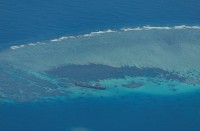
Reuters — Filipino fishermen at a disputed shoal have regained their livelihood by fishing inside a disputed shoal following closer bilateral ties between Manila and Beijing in recent months.
Far out in the South China Sea, where dark blue meets bright turquoise, a miles-long row of fishing boats anchor near Scarborough Shoal, backed by a small armada of coastguard projecting China’s power in Asia’s most disputed waters.
China still calls the shots at the prime fishing spot and has boosted its fleet there, nine months after an international panel ruled its blockade of the lagoon was illegal.
Beijing rejected that ruling by the Permanent Court of Arbitration, which invalidated China’s claim of sovereignty over most of the South China Sea.
But the presence of Philippine boats dotted between Chinese vessels shows a degree of compliance with the ruling. Overtures from Philippine President Rodrigo Duterte, who is negotiating billions of dollars worth of loans, investments and trade deals with China, may have helped.
China stopped repelling Filipino boats in October and allowed them to fish on the edges of the rocky outcrop, 200 km (124 miles) from the Philippines. Now it appears to be easing restrictions further.
Filipino fishing boat captain Ramil Rosal says the Chinese coastguard are still guarding the shoal and have set restrictions by only allowing small boats inside.
He also observed more Chinese fishing vessels in the area, but was unconcerned because the Chinese fishermen have established good ties with them.
However Renato Etac, another Filipino fishing boat captain who has been fishing in the shoal for decades, says they catch less fish since the Chinese fishing vessels have been working in the area.
The coral outcrop is synonymous with the struggle for regional power, and a strategic tinder box. Along with China and the Philippines, Scarborough is claimed by Taiwan and Vietnam.
Despite its concessions, China’s presence here is growing, with a larger contingent of coastguard and fishing boats than was indicated in satellite imagery late last year.







